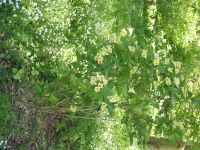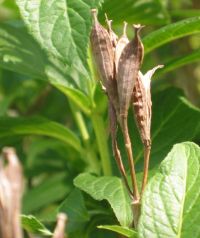Middendorff weigela - Weigela middendorffiana
English name:
Middendorff weigela
Scientific name:
Weigela middendorffiana
Family:
Caprifoliaceae (Honeysuckle family)
Height:
to 1.5 m
Flowering:
May and early June
Range:
Japan, Korea, N. China, Russian far east
 |
|
 |
 |
Plant description:
The Weigela middendorffiana in the pictures is from seed collected by the Nordic Arboretum Committee expedition to Japan in 1976. The seed was collected on the active volcano, Mt. Asahi in Daisetsuzan National Park, on the Island of Hokkaido. It can be found in square 1310 positions 1008 to 1239 on the edge of the second grass plain near Søvejen (the Lake road). A map with squares and positions can be found on our homepage under: Plant search.
The genus Weigela is composed of 10 species all of which come from East Asia. The genus has produced a number of garden cultivars, known for their beautiful flowers. Many cultivars are hybrids between the distinct species. Flowering occurs in May for the earliest species and the latest species can be flowering in early July at the Arboretum in Hørsholm. We have 6 species of Weigela in our collection.
We have 19 examples of Weigela middendorffiana in the Arboretum. Thirteen are from seed collected in the wild on the island of Hokkaido during the Nordic Arboretum Committees expedition to Japan in 1976. We also have examples from Russia and China.
Weigela middendorffiana was grown as early as 1890 in the Botanic garden in Copenhagen. But it was mentioned as early as 1851 as a new Weigela that was being sold in England. Our first introduction to the Arboretum was a cutting received in 1944 from the Agricultural Universitys Botanic garden. This first introduction has not survived and our oldest living plants are from the Nordic Arboretum Expedition to Japan in 1976.
These are deciduous shrubs about 1.5 m tall with greyish scaling bark. The new shoots have two longitudinal lines of hairs. Leaves are oblong to narrowly ovate with a drawn-out tip. They are finely toothed, with short hairs on the veins on the upper surface and fairly densely hairy beneath. The flowers are narrowly bell shaped and about 3.5 cm long. They occur in groups of 1 to 3 in the upper leaf axels and terminally at the end of branches. The corolla is bell-shaped and sulphur yellow with a spot on the lower lobes that becomes orange. The calyx (sepals) is two lipped and fringed with short bristles.
W. middendorffiana is a beautiful flowering shrub. It received an Award of Merit in 1931 from the Royal Horticultural Society. Seven named clones are listed as available in the RHS Plant Finder book. The species thrives best in half shade and can be recommended as a garden plant. Our bushes are not so densely covered with flowers as in other species of this genus, for example, W. subsessilis, but the flowers are larger. In Hørsholm it flowers before the related W. maximowitzii. The Hokkaido provenances we have are well adapted to the Danish climate.
References:
Bean, W.J. 1980 Trees and Shrubs Hardy in the British Isles Vol IV. Ri.-Z. John Murray publishers. 808 pp.
Lange, J. 1999. Kulturplanternes Indførselshistorie i Danmark indtil midten af 1900-talet. (Introduction History of Cultivated Plants in Denmark up to the middle of the 20th century). DSR Forlag, Frederiksberg C. 458 pp.
Mabberley, D.J. 1998. The Plant Book. The Bath Press, Bath, 858 pp.
Olsen, O. et al. 1997 Havens Planteleksikon. Træer og Buske. (Danish Plant Encyclopedia, Trees & Bushes). Det Danske Haveselskab Publisher, 674 pp.
Cullen, J. et al. (ed.) 2000. The European Garden Flora. Vol VI. Cambridge University Press, Cambridge United Kingdom. 739 pp
